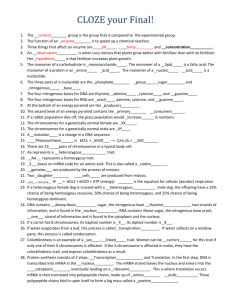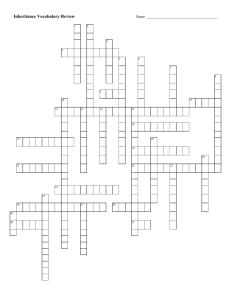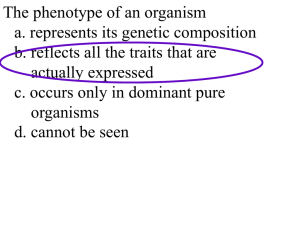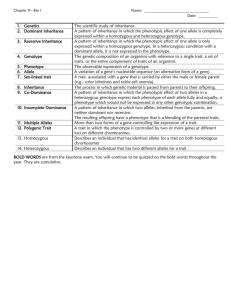CLOZE your Final! The ___control______ group is the group that is
advertisement
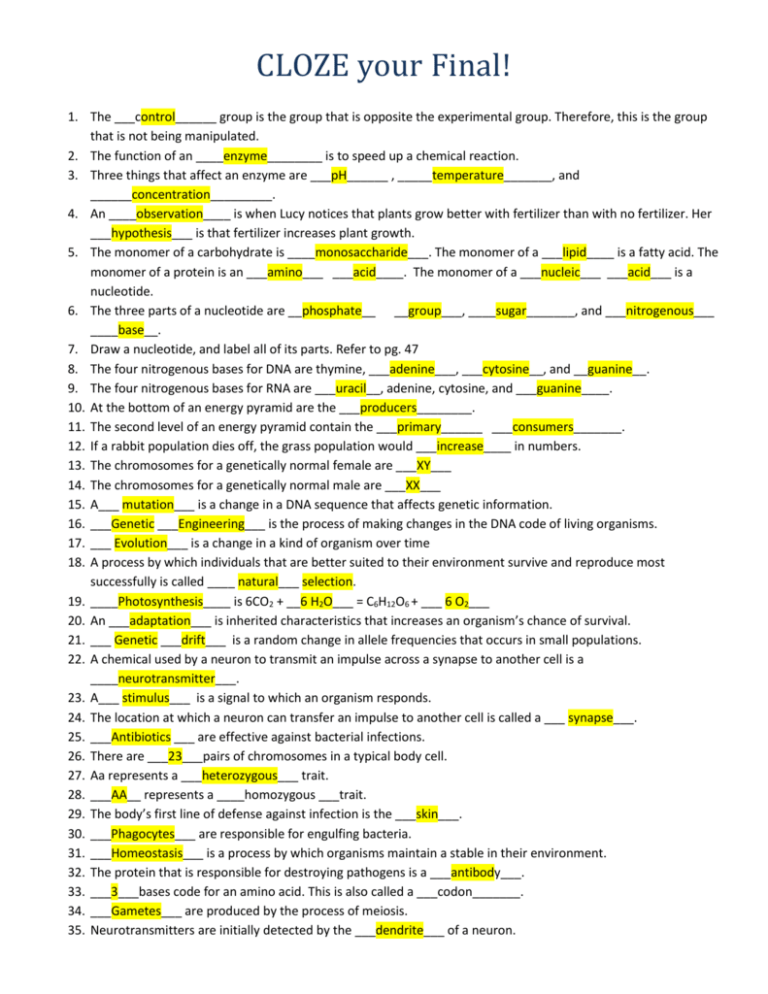
CLOZE your Final! 1. The ___control______ group is the group that is opposite the experimental group. Therefore, this is the group that is not being manipulated. 2. The function of an ____enzyme________ is to speed up a chemical reaction. 3. Three things that affect an enzyme are ___pH______ , _____temperature_______, and ______concentration_________. 4. An ____observation____ is when Lucy notices that plants grow better with fertilizer than with no fertilizer. Her ___hypothesis___ is that fertilizer increases plant growth. 5. The monomer of a carbohydrate is ____monosaccharide___. The monomer of a ___lipid____ is a fatty acid. The monomer of a protein is an ___amino___ ___acid____. The monomer of a ___nucleic___ ___acid___ is a nucleotide. 6. The three parts of a nucleotide are __phosphate__ __group___, ____sugar_______, and ___nitrogenous___ ____base__. 7. Draw a nucleotide, and label all of its parts. Refer to pg. 47 8. The four nitrogenous bases for DNA are thymine, ___adenine___, ___cytosine__, and __guanine__. 9. The four nitrogenous bases for RNA are ___uracil__, adenine, cytosine, and ___guanine____. 10. At the bottom of an energy pyramid are the ___producers________. 11. The second level of an energy pyramid contain the ___primary______ ___consumers_______. 12. If a rabbit population dies off, the grass population would ___increase____ in numbers. 13. The chromosomes for a genetically normal female are ___XY___ 14. The chromosomes for a genetically normal male are ___XX___ 15. A___ mutation___ is a change in a DNA sequence that affects genetic information. 16. ___Genetic ___Engineering___ is the process of making changes in the DNA code of living organisms. 17. ___ Evolution___ is a change in a kind of organism over time 18. A process by which individuals that are better suited to their environment survive and reproduce most successfully is called ____ natural___ selection. 19. ____Photosynthesis____ is 6CO2 + __6 H2O___ = C6H12O6 + ___ 6 O2___ 20. An ___adaptation___ is inherited characteristics that increases an organism’s chance of survival. 21. ___ Genetic ___drift___ is a random change in allele frequencies that occurs in small populations. 22. A chemical used by a neuron to transmit an impulse across a synapse to another cell is a ____neurotransmitter___. 23. A___ stimulus___ is a signal to which an organism responds. 24. The location at which a neuron can transfer an impulse to another cell is called a ___ synapse___. 25. ___Antibiotics ___ are effective against bacterial infections. 26. There are ___23___pairs of chromosomes in a typical body cell. 27. Aa represents a ___heterozygous___ trait. 28. ___AA__ represents a ____homozygous ___trait. 29. The body’s first line of defense against infection is the ___skin___. 30. ___Phagocytes___ are responsible for engulfing bacteria. 31. ___Homeostasis___ is a process by which organisms maintain a stable in their environment. 32. The protein that is responsible for destroying pathogens is a ___antibody___. 33. ___3___bases code for an amino acid. This is also called a ___codon_______. 34. ___Gametes___ are produced by the process of meiosis. 35. Neurotransmitters are initially detected by the ___dendrite___ of a neuron. CLOZE your Final! 36. 37. 38. 39. 40. 41. 42. 43. 44. 45. 46. 47. 48. 49. 50. 51. 52. 53. 54. 55. 56. 57. 58. Two __ daughter _ __cells___ are produced from mitosis. ___6O2 + C6H12O6 _____ ____6CO2 + 6H2O____ + _____Energy____ is the equation for cellular respiration. Different proteins exist because they have different ____functions___ for the cell. A __mutation___ is a change in DNA. When species cannot mate because they are physically separated from one another, this is called __geographic____ isolation. When species cannot mate because they mate at separate times of the year, this is called __temporal___ isolation. Both kinds of isolation are considered to be types of ___reproductive___ isolation. When allele frequencies change in a population, this is __genetic__ __drift__. When allele frequencies stay the same, it is genetic ___equilibrium__. The four evidences for evolution listed by scientists are the fossil record, ___similar___ ___ embryology__, geographic distribution, and ___homologous___ structures. A person infected with __HIV__ will eventually develop AIDS. This person potentially becomes seriously ill from the common cold or a seasonal flu, because his __immune__ system is too weak. The __skin__ is the most important line of first defense. A __sensory__ neuron carries the message from the 5 senses to the central nervous system. The motor neuron carries the message from the central nervous system to a muscle. If a heterozygous female dog is crossed with a __heterozygous__ male dog, the offspring have a 25% chance of being homozygous recessive, 50% chance of being heterozygous, and 25% chance of being homozygous dominant. DNA contains _deoxyribose_ sugar, the nitrogenous base ____thymine__, two strands of information, and is found in the __nucleus__. RNA contains ribose sugar, the nitrogenous base uracil, __one__ strand of information is found in the cytoplasm. If a carrot has 8 chromosomes, its haploid number is __4___. Its diploid number is ___8___. If water evaporates from a leaf, this process is called __transpiration__. If water collects on a window pane, this process is called condensation. Colorblindness is an example of a __sex_-__linked__ trait. Women can be __carriers__ for this trait if only one of their X chromosomes is affected. If the X chromosome is affected in males, they have the colorblindness trait, and express colorblindness as a result. A __pedigree___ is a family tree that shows the genotype of each person in the family. An __adaptation___ is a characteristic that helps an organism to become “fitter” in its environment. Lethal homozygous recessive diseases always remain in a population because its __heterozygous__ form is NOT lethal. Carriers survive to pass on the lethal homozygous allele. A __white___ blood cell is also known as a phagocyte, and engulfs bacteria as a part of the immune system. A __red__ blood cell carries oxygen to cells as a part of the __circulatory___ system. Red blood cells need __hemoglobin__ which helps bind oxygen to the cells and distribute it around the body. The internal environment of any organism is maintained in “balance” through __homeostasis__, apart from the external environment. The heating system of a house can be considered a __negative__ feedback loop, because the heater shuts off if the room gets too hot, and the heater turns back on when the room gets too __cold__. The endocrine system of the human body works in the same way. __Hormones__ are chemical messengers that are sent via the bloodstream to target certain body cells. An example of these chemical messengers is adrenaline. CLOZE your Final! 59. An __immune__ response is triggered by a protein found on a foreign invader. This protein is also known as an antigen. __Antibodies__ made by the body bind to this antigen like a “lock and key”, and causes the body to fight off the infection using phagocytes. 60. A __stimulus__ causes a reaction in the nervous system by appealing to any of the 5 senses of the body. 61. Protein synthesis consists of 2 steps: ______Transcription__________ and Translation. In the first step, DNA is transcribed into mRNA in the __nucleus__. The mRNA strand leaves the nucleus and enters into the __cytoplasm__, eventually landing on a __ribosome__. This is where translation occurs. mRNA is then translated into polypeptide chains, made up of __amino__ acids. These polypeptide chains fold in upon itself to form a big mass called a __protein__.
